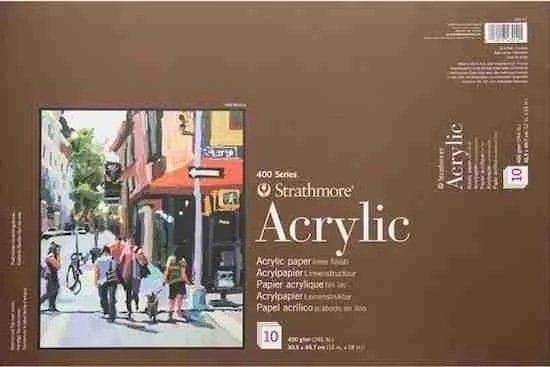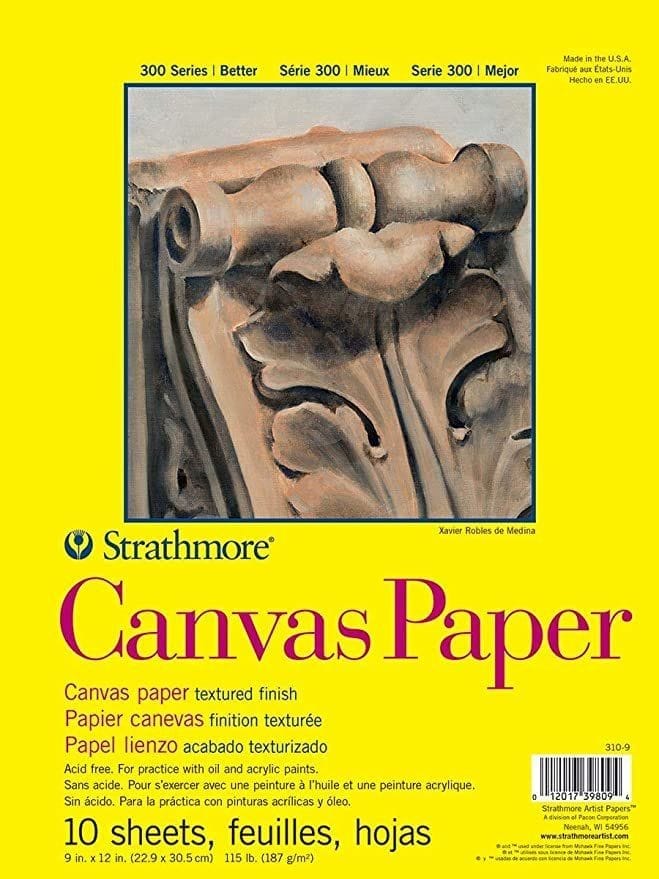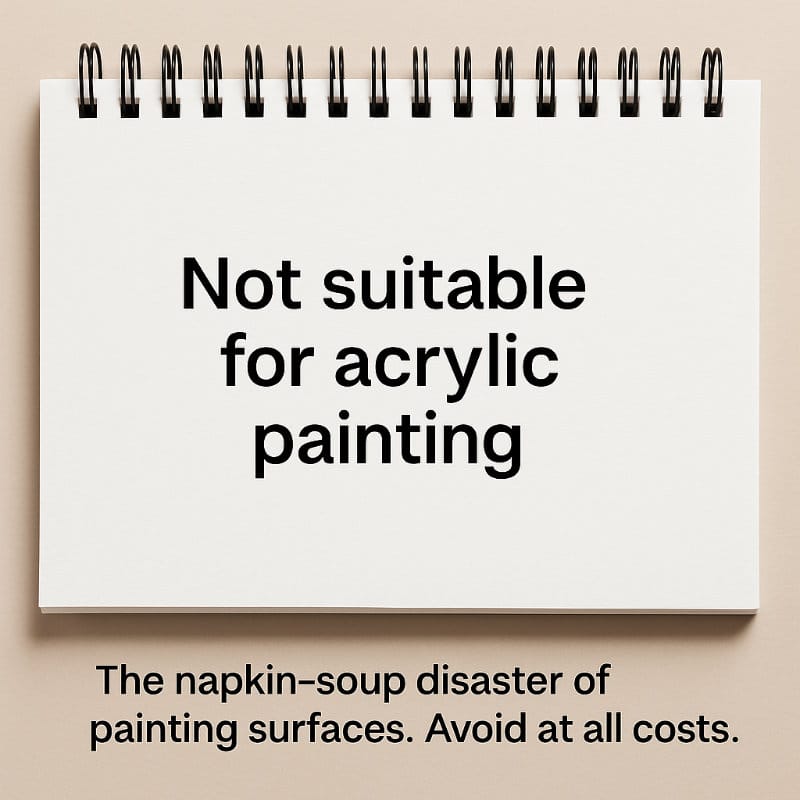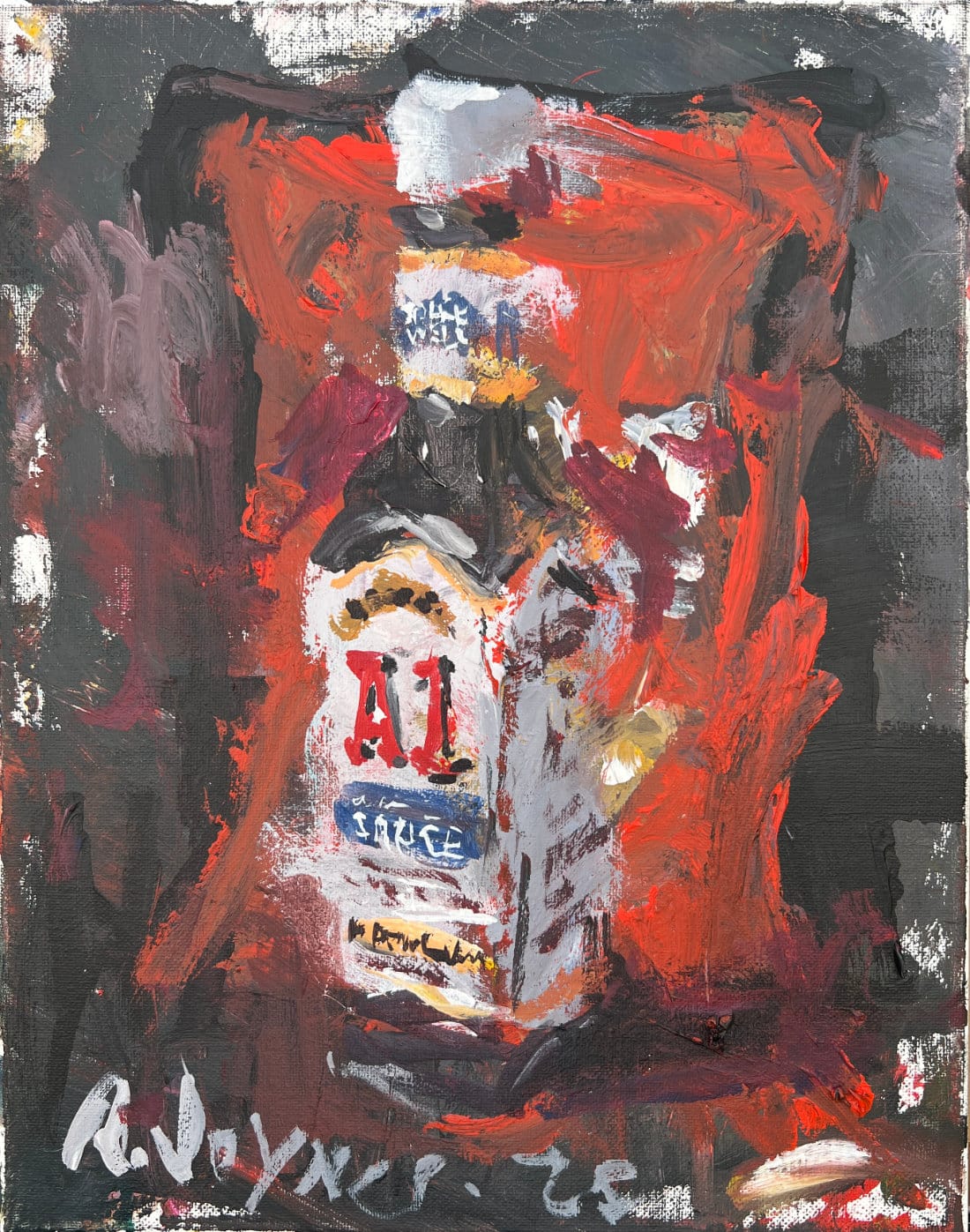Best Paper for Acrylic Painting
We’ve all ordered the “fancy” thing off the menu only to wish we stuck with chips & salsa. Picking the best paper for acrylic painting works the same way — reliable wins every time.

Hey there, before we discuss what is the best paper or acrylic painting, I thought I'd share a quick story that may help guide you. We once thought it would be a brilliant idea to take our kids to our “fancy date-night” Italian spot — white tablecloths, five courses, and waiters who give you side-eye if you ask for extra parmesan. Big mistake.
The kids poked at their food, whispered “where’s the chips & salsa?” on repeat, and we walked out wishing we had just gone to our favorite Mexican place down the road. Reliable, fun, and guaranteed happiness thanks to endless chips and salsa.
Choosing the best paper for acrylic painting works the same way. You can chase the “fancy” stuff — specialty papers that promise magic results but usually frustrate beginners. Or you can stick with the “chips and salsa” option: dependable, heavyweight acrylic or watercolor paper that always delivers. The trick is knowing which papers are worth your money, which ones are just hype, and which should be avoided altogether.
🔗 Looking for more acrylic tips, tutorials, and resources?
Check out the Acrylic Hub — your one-stop guide for everything from beginner basics to advanced techniques.
Top Picks (Quick List)
- Strathmore 400 Series Acrylic Pad — heavyweight, toothy, resists buckling; the most reliable “chips & salsa” choice.
- Canson Acrylic Pad — smoother glide, still durable and budget-friendly; great daily driver for studies.
- Canson Figueras (Canva-Paper) — canvas-like texture without the bulk or cost; ideal for studies or finished pieces you can mount later.

Reliable Picks: Best Paper for Acrylic Painting
When you’re starting out (or even if you’ve painted for years), the safest choice is heavyweight, acid-free paper designed for acrylics or watercolors. Think of these like your go-to Mexican restaurant: consistent, forgiving, and always a good experience.
Strathmore 400 Series Acrylic Paper
My #1 recommendation. At 140 lb/300 gsm, it’s thick, durable, and has a nice tooth that grabs acrylic paint without buckling. It can handle my heavy-handed brushstrokes, all the layering you can think of, scraping, and corrections with ease. If you want a “no drama” surface that works for both practice and finished art, this is it.
Canson Acrylic Pads
A close runner-up, slightly smoother but still worthy. Great for students and hobbyists who want a balance of affordability and durability.

These papers are the equivalent of chips and salsa: they don’t try to be flashy, but they never disappoint. Start here, and you’ll save yourself the frustration (and wasted money) of papers that just aren’t cut out for acrylics.
When Fancy Works
Sometimes it’s worth dressing up and trying something different — we are talking date night with the wife, kids aren’t invited. The same goes for paper. While your reliable acrylic pads will cover 90% of your painting needs, there are a few “fancier” surfaces that can add a unique twist to your work.

Black Canvas Paper (Strathmore)
Want to shake things up? Painting on black paper is like ordering squid ink pasta — bold, striking, and not for everyone. But it makes colors pop in unexpected ways and forces you to think differently about light and layering. If you’re feeling adventurous, this “fancy” option can unlock new creative directions.
The key with these papers is knowing when to use them. They’re not your “chips and salsa” everyday workhorses, but they can absolutely elevate your painting experience when you’re in the mood for something different.

Papers to Avoid
Every menu has a few “what were they thinking?” items. In restaurants, it’s escargot for the kids or a $12 kale smoothie nobody orders. In acrylic painting, it’s the bargain-bin or overly slick papers that look fine at first glance but turn into disasters once the paint hits.
Here are the big ones to avoid:
- Lightweight Paper (under 120 lb / 200 gsm)
This is like serving soup on a paper plate. Thin paper buckles, warps, and tears the second acrylic paint touches it. Save yourself the headache — always go heavy. - Glossy or Coated Paper
Same result here: acrylic paint beads up, slides around, and refuses to stick. Glossy = slippery = frustration. - Non-Archival Paper
Using non-archival paper is like leaving leftovers in a Styrofoam container on the dashboard. It yellows, gets brittle, and makes your painting age in fast-forward. If you care about longevity, always look for “acid-free” and “archival” on the label.
Bottom line: if the paper feels flimsy, shiny, or suspiciously cheap, treat it like a questionable restaurant special and walk away.
Why Paper Can Beat Canvas
Canvas gets all the love, but paper has its own superpowers — and sometimes it’s the smarter choice:
- Affordable → You can paint daily without feeling like you’re racking up a fine-dining bill.
- Portable → Lightweight and easy to store (stackable like to-go taco boxes).
- Forgiving → Messed up? Flip it over or start fresh on another sheet. Try doing that with a canvas.
- Flexible Sizes → From postcard-sized sketches to giant rolls, paper bends to your workflow.
- Oops, I messed up → there's less pressure to create a 'masterpiece right now!!!'. Paper just isn't that demanding, personally I can say there's less pressure to paint the next Mona Lisa and more room to relax and paint.
Paper is the weeknight taco joint — reliable, affordable, and perfect for experimentation. Canvas is Saturday night out. Both have their place, but don’t underestimate the paper side of the menu.
How to Store Acrylic Paintings on Paper
Even the best meal can go downhill if you don’t store the leftovers right. Same with acrylic paintings on paper — you want them to last, not wilt like soggy nachos.
- Keep It Cool, Dark, and Dry → Avoid direct sunlight, damp basements, or anywhere that feels like a hot pizza oven.
- Use Acid-Free Materials → Store in archival folders, sleeves, or boxes so the paper doesn’t yellow or get brittle.
- Separate With Tissue or Glassine → Think of it as wax paper between burritos — prevents sticking and smudging.
- Handle With Clean Hands (or Gloves) → No greasy fingerprints, please.
- Consider Archival Bags → Like take-out containers for art, they protect from dust, moisture, and curious kids.
With a little care, your paper pieces will stay fresh and ready to “reheat” for years to come.

Frequently Asked Questions About Paper for Acrylic Painting
What is the best paper for acrylic painting?
The best paper for acrylic painting is heavyweight, acid-free, and designed for acrylics or watercolors. Think of it as your reliable chips-and-salsa option — it never lets you down. Strathmore 400 Series and Canson Acrylic Pads are my top choices.
Can you use watercolor paper for acrylics?
Absolutely. Good watercolor paper handles acrylics beautifully. Anything lighter is like trying to serve soup in a napkin — it just won’t hold up. I use it all the time!
Is canvas paper good for acrylic painting?
Yes! Canvas paper has become really popular. It mimics the texture of stretched canvas but is cheaper, lighter, and easier to store. I still prefer regular paper and standard stretched canvas, but it does work fine.
Do you need to prime paper for acrylic painting?
Most acrylic and watercolor papers are ready to go straight from the pad. If you want extra strength, a coat of gesso is like asking for extra guac — not required, but it can enhance the experience. I have never done it but I know plenty of artists that do.
What paper should beginners avoid for acrylic painting?
Skip thin sketch pads, glossy paper, and anything non-archival. These are the escargot-for-kids of painting surfaces — looks fancy on the menu but leads to nothing but regret.
Wrap It Up
Choosing the best paper for acrylic painting doesn’t have to be overwhelming. Skip the escargot, don’t fall for overpriced specials, and remember that your “chips and salsa” standbys — heavyweight, acid-free acrylic or watercolor paper — will almost always hit the spot.
- Reliable everyday picks → Strathmore 400 Series, Canson Acrylic Pads.
- Fancy splurges → Canvas paper or black canvas paper when you want something different.
- Hard no’s → Thin, glossy, or non-archival paper.
At the end of the day, art is about creating, not fussing over the menu. Start with reliable paper, paint consistently, and you’ll get better faster — without the side of regret.
Learn & Improve Your Acrylic Skills
- Acrylic Hub– Your go-to guide for tutorials, tips, and resources.
- Subscribe for More Great Content - Get tutorials, tips, and updates straight to your inbox.
- Follow Me on Pinterest - Daily inspiration, tips, and fresh ideas.




